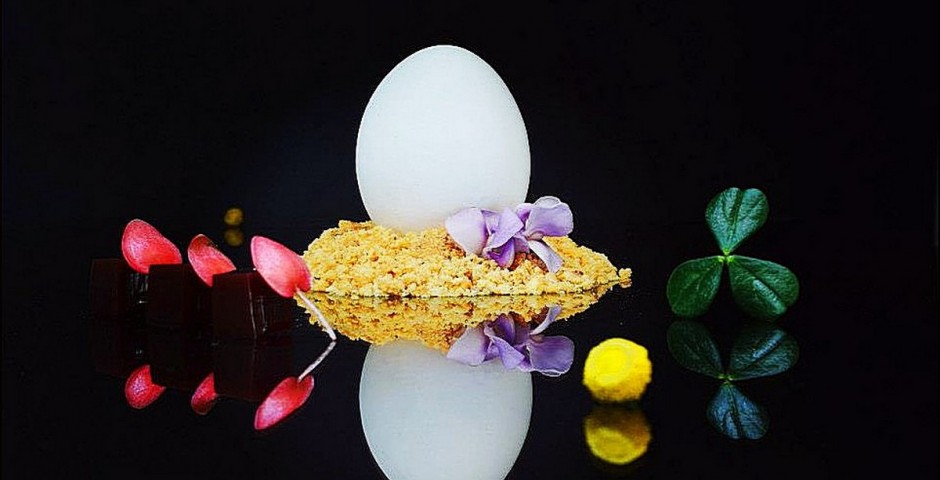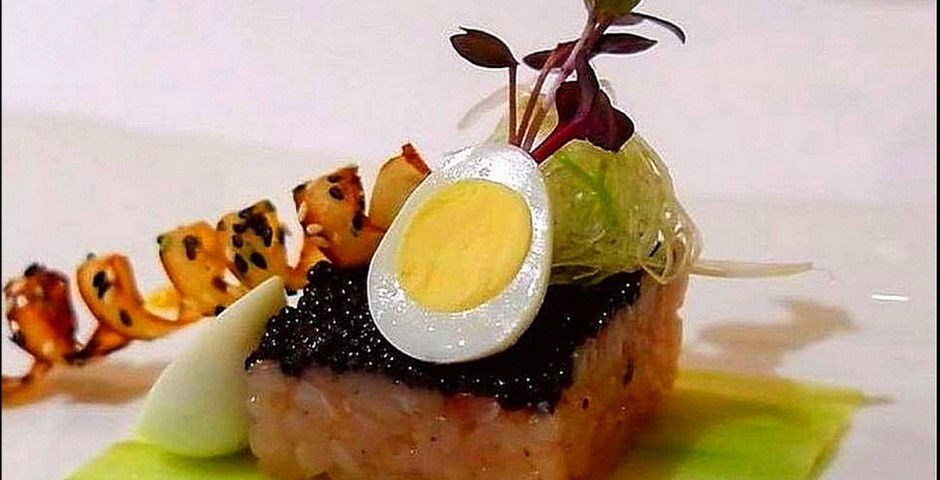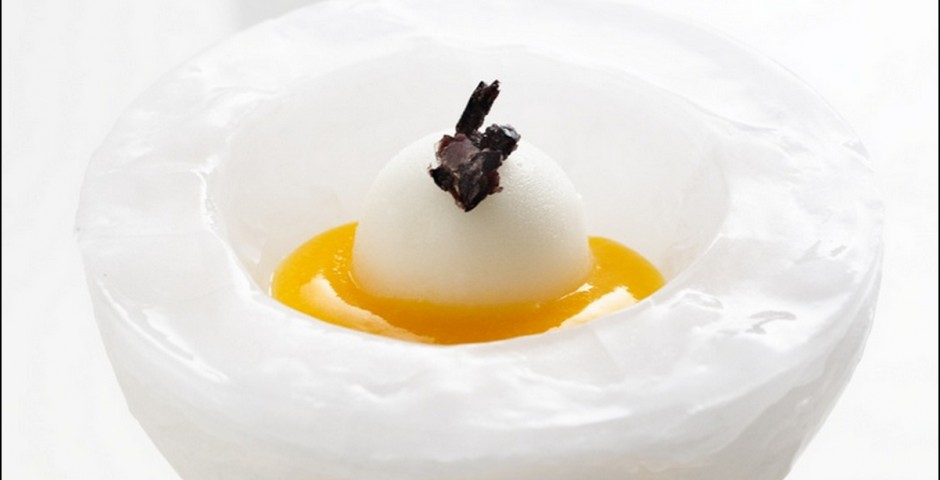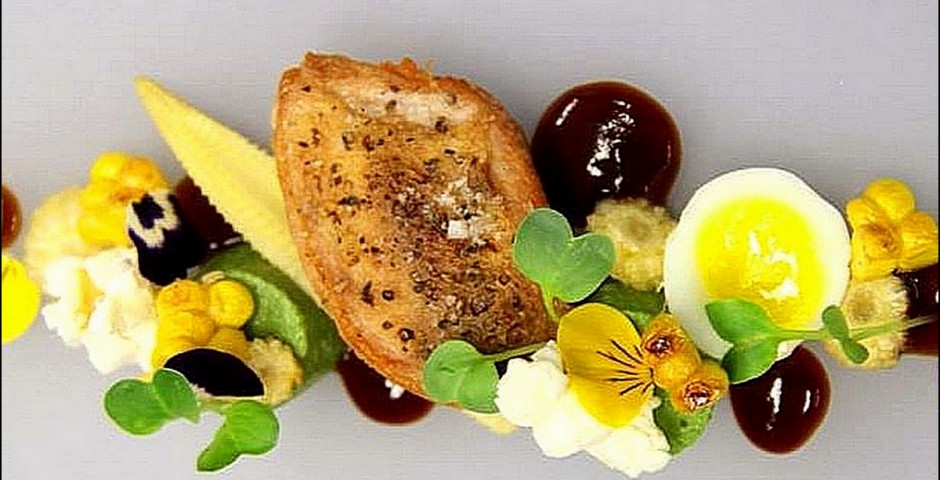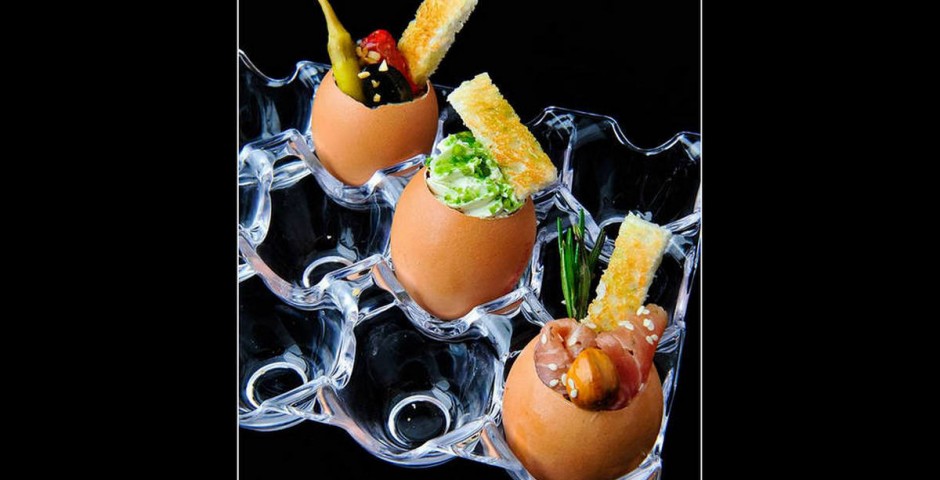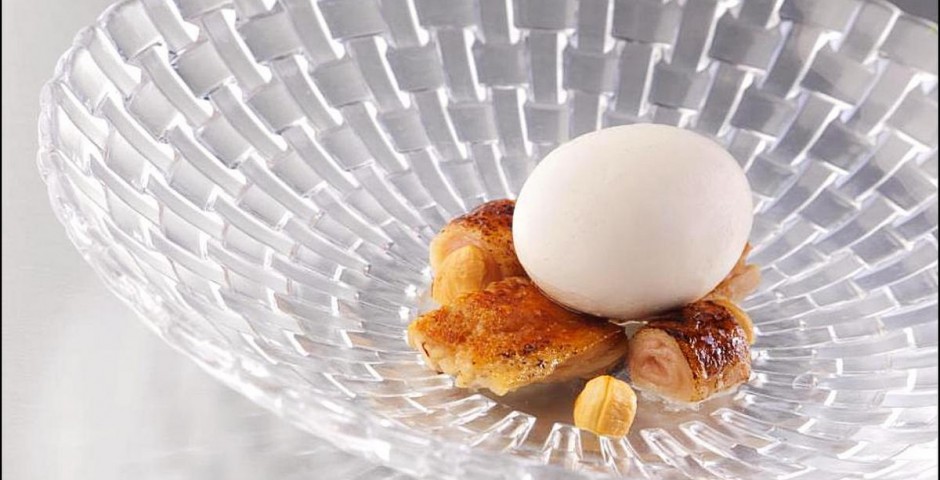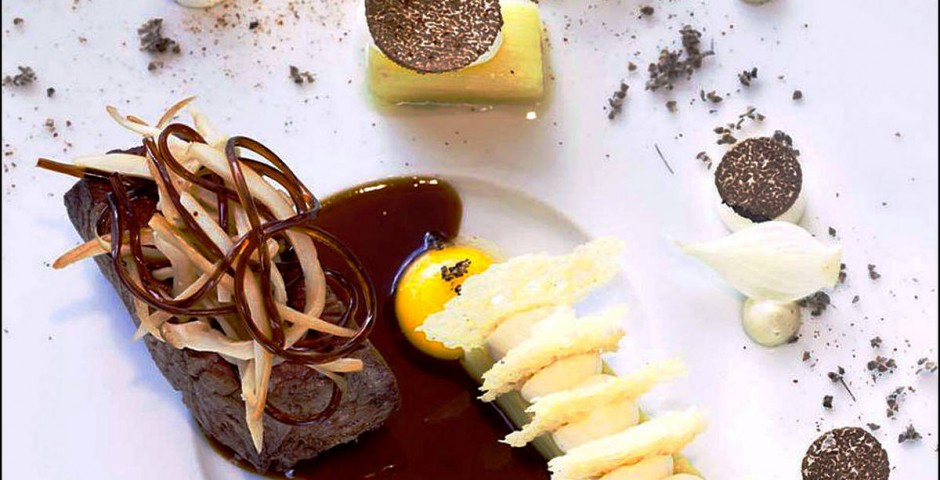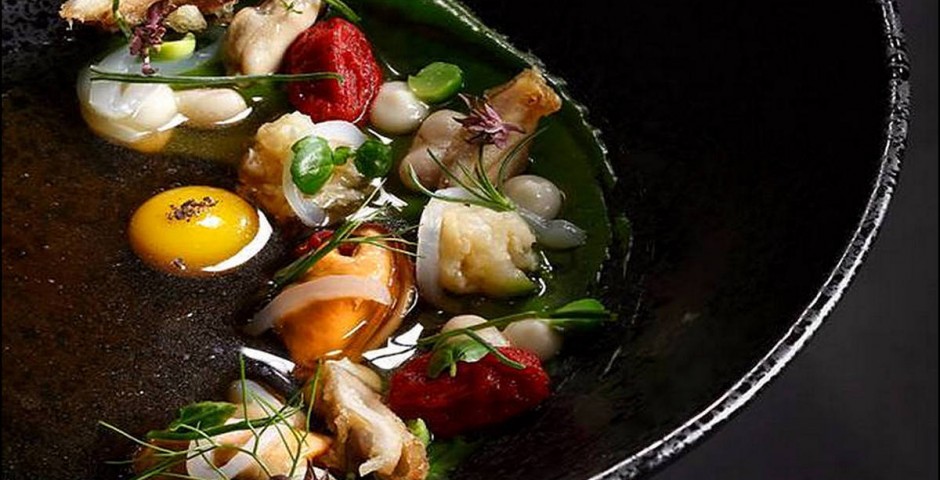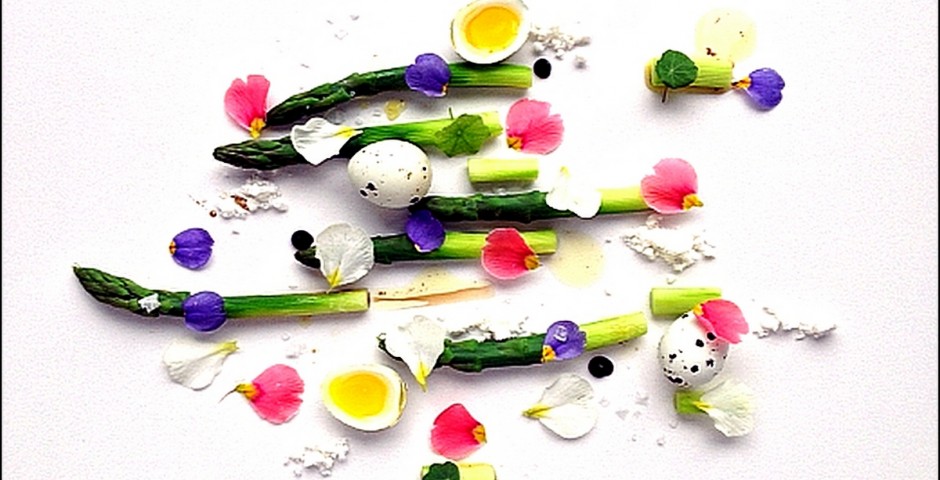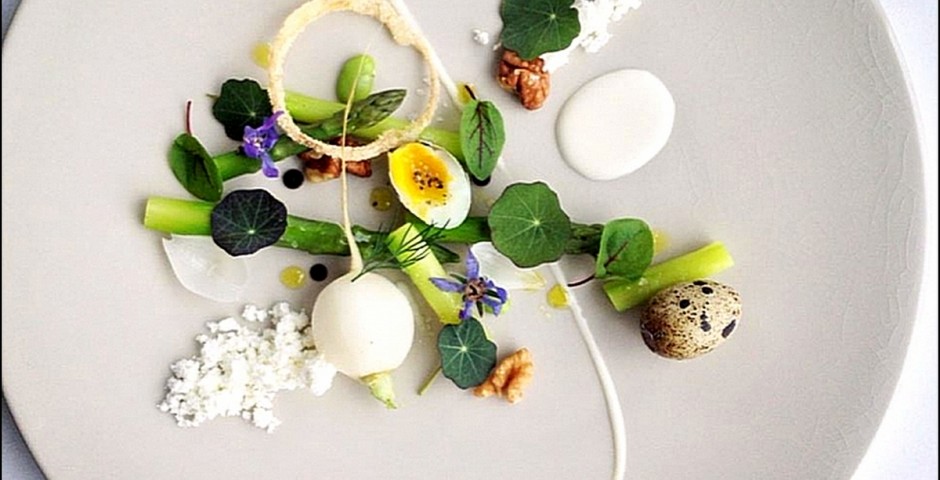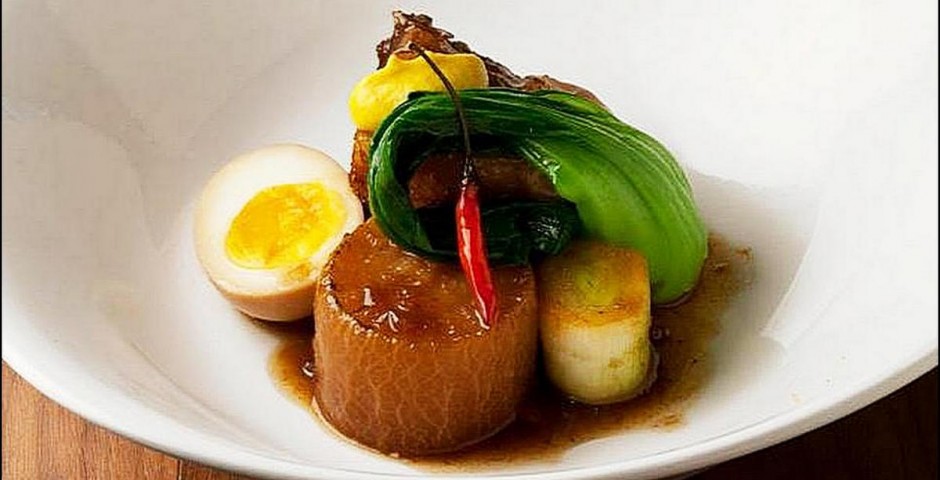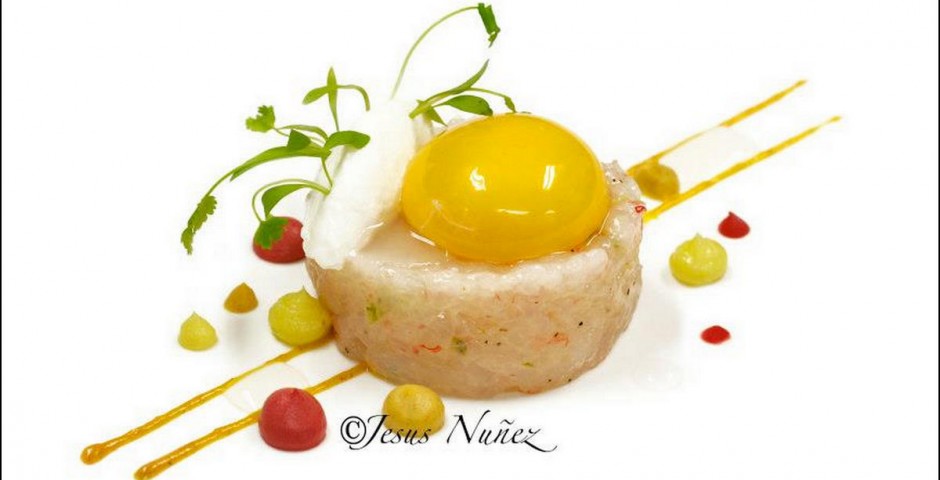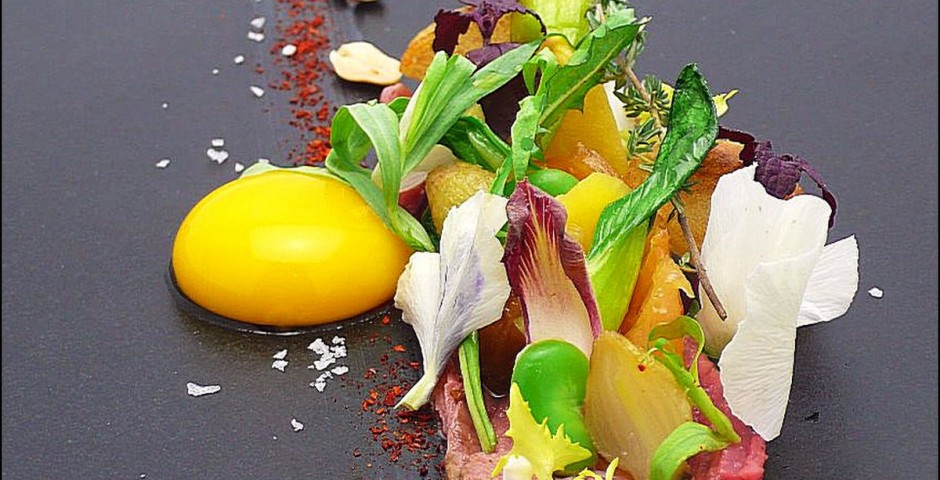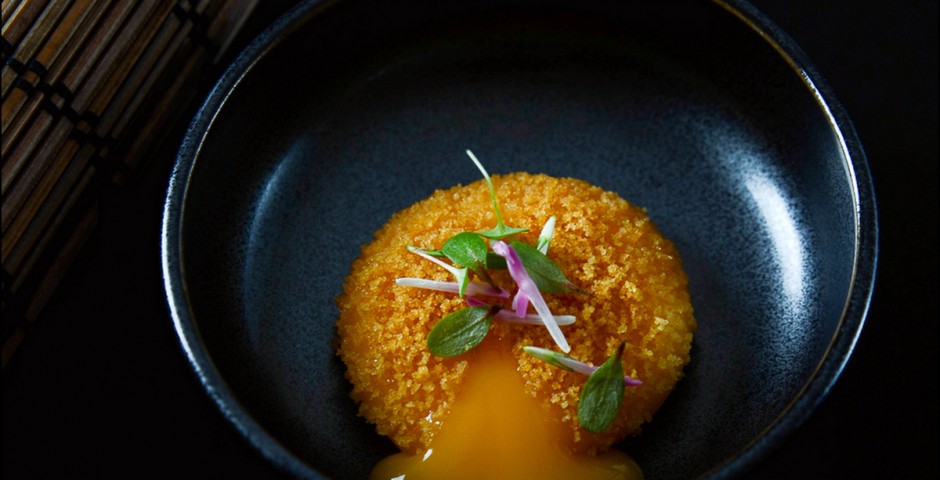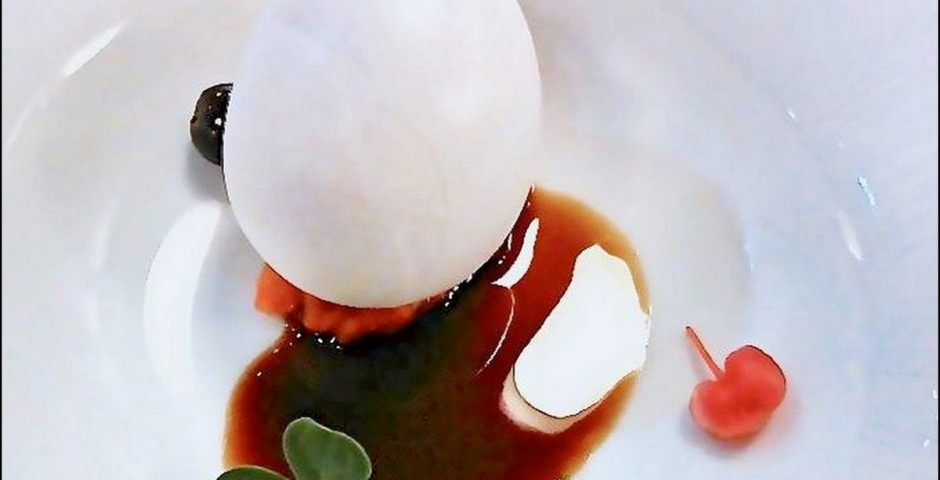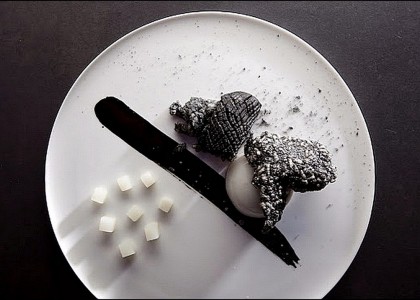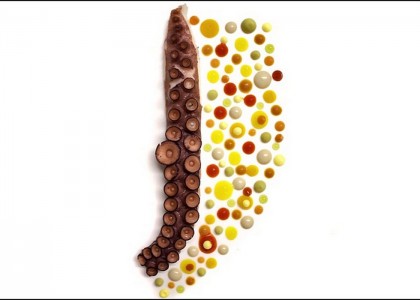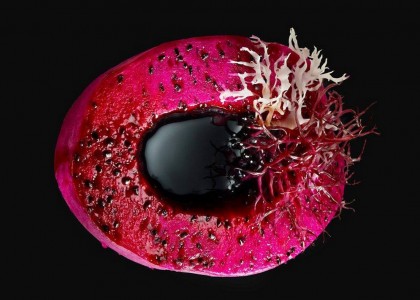
Bird eggs have been valuable foodstuffs since prehistory, in both hunting societies and more recent cultures where birds were domesticated. The chicken was probably domesticated for its eggs from jungle fowl native to tropical and subtropical Southeast Asia and India before 7500 BCE. Chickens were brought to Sumer and Egypt by 1500 BCE, and arrived in Greece around 800 BCE, where the quail had been the primary source of eggs. In Thebes, Egypt, the tomb of Haremhab, built about 1420 BCE, shows a depiction of a man carrying bowls of ostrich eggs and other large eggs, presumably those of the pelican, as offerings. In ancient Rome, eggs were preserved using a number of methods, and meals often started with an egg course. The Romans crushed the shells in their plates to prevent evil spirits from hiding there. In the Middle Ages, eggs were forbidden during Lent because of their richness. The word mayonnaise possibly was derived from moyeu, the medieval French word for the yolk, meaning center or hub.
Egg scrambled with acidic fruit juices were popular in France in the 17th century; this may have been the origin of lemon curd.
The dried egg industry developed in the 19th century, before the rise of the frozen egg industry. In 1878, a company in St. Louis, Missouri started to transform egg yolk and white into a light-brown, meal-like substance by using a drying process. The production of dried eggs significantly expanded during World War II, for use by the United States Armed Forces and its allies.
In 1911, the egg carton was invented by Joseph Coyle in Smithers, British Columbia, to solve a dispute about broken eggs between a farmer in Bulkley Valley and the owner of the Aldermere Hotel. Early egg cartons were made of paper.
.
In this thematic album, you will find some inspiration on different ways to present on this topic...
To enrich this album, you can send us :
- All great photos of dressings on this topic you will find on the web,
- Your personal photos dressage on this topic ...
You can also suggest us to introduce new thematic albums if you have ideas for topics that we have not yet implemented.
You will find all the other thematic albums :
If you wish to publish a photo to add to this topic, do not hesitate to send using our > Contact Form  .
.
.

Bird eggs have been valuable foodstuffs since prehistory, in both hunting societies and more recent cultures where birds were domesticated. The chicken was probably domesticated for its eggs from jungle fowl native to tropical and subtropical Southeast Asia and India before 7500 BCE. Chickens were brought to Sumer and Egypt by 1500 BCE, and arrived in Greece around 800 BCE, where the quail had been the primary source of eggs. In Thebes, Egypt, the tomb of Haremhab, built about 1420 BCE, shows a depiction of a man carrying bowls of ostrich eggs and other large eggs, presumably those of the pelican, as offerings. In ancient Rome, eggs were preserved using a number of methods, and meals often started with an egg course. The Romans crushed the shells in their plates to prevent evil spirits from hiding there. In the Middle Ages, eggs were forbidden during Lent because of their richness. The word mayonnaise possibly was derived from moyeu, the medieval French word for the yolk, meaning center or hub.
Egg scrambled with acidic fruit juices were popular in France in the 17th century; this may have been the origin of lemon curd.
The dried egg industry developed in the 19th century, before the rise of the frozen egg industry. In 1878, a company in St. Louis, Missouri started to transform egg yolk and white into a light-brown, meal-like substance by using a drying process. The production of dried eggs significantly expanded during World War II, for use by the United States Armed Forces and its allies.
In 1911, the egg carton was invented by Joseph Coyle in Smithers, British Columbia, to solve a dispute about broken eggs between a farmer in Bulkley Valley and the owner of the Aldermere Hotel. Early egg cartons were made of paper.
.
In this thematic album, you will find some inspiration on different ways to present on this topic...
To enrich this album, you can send us :
- All great photos of dressings on this topic you will find on the web,
- Your personal photos dressage on this topic ...
You can also suggest us to introduce new thematic albums if you have ideas for topics that we have not yet implemented.
You will find all the other thematic albums :
If you wish to publish a photo to add to this topic, do not hesitate to send using our > Contact Form  .
.
.

Bird eggs have been valuable foodstuffs since prehistory, in both hunting societies and more recent cultures where birds were domesticated. The chicken was probably domesticated for its eggs from jungle fowl native to tropical and subtropical Southeast Asia and India before 7500 BCE. Chickens were brought to Sumer and Egypt by 1500 BCE, and arrived in Greece around 800 BCE, where the quail had been the primary source of eggs. In Thebes, Egypt, the tomb of Haremhab, built about 1420 BCE, shows a depiction of a man carrying bowls of ostrich eggs and other large eggs, presumably those of the pelican, as offerings. In ancient Rome, eggs were preserved using a number of methods, and meals often started with an egg course. The Romans crushed the shells in their plates to prevent evil spirits from hiding there. In the Middle Ages, eggs were forbidden during Lent because of their richness. The word mayonnaise possibly was derived from moyeu, the medieval French word for the yolk, meaning center or hub.
Egg scrambled with acidic fruit juices were popular in France in the 17th century; this may have been the origin of lemon curd.
The dried egg industry developed in the 19th century, before the rise of the frozen egg industry. In 1878, a company in St. Louis, Missouri started to transform egg yolk and white into a light-brown, meal-like substance by using a drying process. The production of dried eggs significantly expanded during World War II, for use by the United States Armed Forces and its allies.
In 1911, the egg carton was invented by Joseph Coyle in Smithers, British Columbia, to solve a dispute about broken eggs between a farmer in Bulkley Valley and the owner of the Aldermere Hotel. Early egg cartons were made of paper.
.
In this thematic album, you will find some inspiration on different ways to present on this topic...
To enrich this album, you can send us :
- All great photos of dressings on this topic you will find on the web,
- Your personal photos dressage on this topic ...
You can also suggest us to introduce new thematic albums if you have ideas for topics that we have not yet implemented.
You will find all the other thematic albums :
If you wish to publish a photo to add to this topic, do not hesitate to send using our > Contact Form  .
.
.

Bird eggs have been valuable foodstuffs since prehistory, in both hunting societies and more recent cultures where birds were domesticated. The chicken was probably domesticated for its eggs from jungle fowl native to tropical and subtropical Southeast Asia and India before 7500 BCE. Chickens were brought to Sumer and Egypt by 1500 BCE, and arrived in Greece around 800 BCE, where the quail had been the primary source of eggs. In Thebes, Egypt, the tomb of Haremhab, built about 1420 BCE, shows a depiction of a man carrying bowls of ostrich eggs and other large eggs, presumably those of the pelican, as offerings. In ancient Rome, eggs were preserved using a number of methods, and meals often started with an egg course. The Romans crushed the shells in their plates to prevent evil spirits from hiding there. In the Middle Ages, eggs were forbidden during Lent because of their richness. The word mayonnaise possibly was derived from moyeu, the medieval French word for the yolk, meaning center or hub.
Egg scrambled with acidic fruit juices were popular in France in the 17th century; this may have been the origin of lemon curd.
The dried egg industry developed in the 19th century, before the rise of the frozen egg industry. In 1878, a company in St. Louis, Missouri started to transform egg yolk and white into a light-brown, meal-like substance by using a drying process. The production of dried eggs significantly expanded during World War II, for use by the United States Armed Forces and its allies.
In 1911, the egg carton was invented by Joseph Coyle in Smithers, British Columbia, to solve a dispute about broken eggs between a farmer in Bulkley Valley and the owner of the Aldermere Hotel. Early egg cartons were made of paper.
.
In this thematic album, you will find some inspiration on different ways to present on this topic...
To enrich this album, you can send us :
- All great photos of dressings on this topic you will find on the web,
- Your personal photos dressage on this topic ...
You can also suggest us to introduce new thematic albums if you have ideas for topics that we have not yet implemented.
You will find all the other thematic albums :
If you wish to publish a photo to add to this topic, do not hesitate to send using our > Contact Form  .
.
.

Bird eggs have been valuable foodstuffs since prehistory, in both hunting societies and more recent cultures where birds were domesticated. The chicken was probably domesticated for its eggs from jungle fowl native to tropical and subtropical Southeast Asia and India before 7500 BCE. Chickens were brought to Sumer and Egypt by 1500 BCE, and arrived in Greece around 800 BCE, where the quail had been the primary source of eggs. In Thebes, Egypt, the tomb of Haremhab, built about 1420 BCE, shows a depiction of a man carrying bowls of ostrich eggs and other large eggs, presumably those of the pelican, as offerings. In ancient Rome, eggs were preserved using a number of methods, and meals often started with an egg course. The Romans crushed the shells in their plates to prevent evil spirits from hiding there. In the Middle Ages, eggs were forbidden during Lent because of their richness. The word mayonnaise possibly was derived from moyeu, the medieval French word for the yolk, meaning center or hub.
Egg scrambled with acidic fruit juices were popular in France in the 17th century; this may have been the origin of lemon curd.
The dried egg industry developed in the 19th century, before the rise of the frozen egg industry. In 1878, a company in St. Louis, Missouri started to transform egg yolk and white into a light-brown, meal-like substance by using a drying process. The production of dried eggs significantly expanded during World War II, for use by the United States Armed Forces and its allies.
In 1911, the egg carton was invented by Joseph Coyle in Smithers, British Columbia, to solve a dispute about broken eggs between a farmer in Bulkley Valley and the owner of the Aldermere Hotel. Early egg cartons were made of paper.
.
In this thematic album, you will find some inspiration on different ways to present on this topic...
To enrich this album, you can send us :
- All great photos of dressings on this topic you will find on the web,
- Your personal photos dressage on this topic ...
You can also suggest us to introduce new thematic albums if you have ideas for topics that we have not yet implemented.
You will find all the other thematic albums :
If you wish to publish a photo to add to this topic, do not hesitate to send using our > Contact Form  .
.
.

Bird eggs have been valuable foodstuffs since prehistory, in both hunting societies and more recent cultures where birds were domesticated. The chicken was probably domesticated for its eggs from jungle fowl native to tropical and subtropical Southeast Asia and India before 7500 BCE. Chickens were brought to Sumer and Egypt by 1500 BCE, and arrived in Greece around 800 BCE, where the quail had been the primary source of eggs. In Thebes, Egypt, the tomb of Haremhab, built about 1420 BCE, shows a depiction of a man carrying bowls of ostrich eggs and other large eggs, presumably those of the pelican, as offerings. In ancient Rome, eggs were preserved using a number of methods, and meals often started with an egg course. The Romans crushed the shells in their plates to prevent evil spirits from hiding there. In the Middle Ages, eggs were forbidden during Lent because of their richness. The word mayonnaise possibly was derived from moyeu, the medieval French word for the yolk, meaning center or hub.
Egg scrambled with acidic fruit juices were popular in France in the 17th century; this may have been the origin of lemon curd.
The dried egg industry developed in the 19th century, before the rise of the frozen egg industry. In 1878, a company in St. Louis, Missouri started to transform egg yolk and white into a light-brown, meal-like substance by using a drying process. The production of dried eggs significantly expanded during World War II, for use by the United States Armed Forces and its allies.
In 1911, the egg carton was invented by Joseph Coyle in Smithers, British Columbia, to solve a dispute about broken eggs between a farmer in Bulkley Valley and the owner of the Aldermere Hotel. Early egg cartons were made of paper.
.
In this thematic album, you will find some inspiration on different ways to present on this topic...
To enrich this album, you can send us :
- All great photos of dressings on this topic you will find on the web,
- Your personal photos dressage on this topic ...
You can also suggest us to introduce new thematic albums if you have ideas for topics that we have not yet implemented.
You will find all the other thematic albums :
If you wish to publish a photo to add to this topic, do not hesitate to send using our > Contact Form  .
.
.

Bird eggs have been valuable foodstuffs since prehistory, in both hunting societies and more recent cultures where birds were domesticated. The chicken was probably domesticated for its eggs from jungle fowl native to tropical and subtropical Southeast Asia and India before 7500 BCE. Chickens were brought to Sumer and Egypt by 1500 BCE, and arrived in Greece around 800 BCE, where the quail had been the primary source of eggs. In Thebes, Egypt, the tomb of Haremhab, built about 1420 BCE, shows a depiction of a man carrying bowls of ostrich eggs and other large eggs, presumably those of the pelican, as offerings. In ancient Rome, eggs were preserved using a number of methods, and meals often started with an egg course. The Romans crushed the shells in their plates to prevent evil spirits from hiding there. In the Middle Ages, eggs were forbidden during Lent because of their richness. The word mayonnaise possibly was derived from moyeu, the medieval French word for the yolk, meaning center or hub.
Egg scrambled with acidic fruit juices were popular in France in the 17th century; this may have been the origin of lemon curd.
The dried egg industry developed in the 19th century, before the rise of the frozen egg industry. In 1878, a company in St. Louis, Missouri started to transform egg yolk and white into a light-brown, meal-like substance by using a drying process. The production of dried eggs significantly expanded during World War II, for use by the United States Armed Forces and its allies.
In 1911, the egg carton was invented by Joseph Coyle in Smithers, British Columbia, to solve a dispute about broken eggs between a farmer in Bulkley Valley and the owner of the Aldermere Hotel. Early egg cartons were made of paper.
.
In this thematic album, you will find some inspiration on different ways to present on this topic...
To enrich this album, you can send us :
- All great photos of dressings on this topic you will find on the web,
- Your personal photos dressage on this topic ...
You can also suggest us to introduce new thematic albums if you have ideas for topics that we have not yet implemented.
You will find all the other thematic albums :
If you wish to publish a photo to add to this topic, do not hesitate to send using our > Contact Form  .
.
.

Bird eggs have been valuable foodstuffs since prehistory, in both hunting societies and more recent cultures where birds were domesticated. The chicken was probably domesticated for its eggs from jungle fowl native to tropical and subtropical Southeast Asia and India before 7500 BCE. Chickens were brought to Sumer and Egypt by 1500 BCE, and arrived in Greece around 800 BCE, where the quail had been the primary source of eggs. In Thebes, Egypt, the tomb of Haremhab, built about 1420 BCE, shows a depiction of a man carrying bowls of ostrich eggs and other large eggs, presumably those of the pelican, as offerings. In ancient Rome, eggs were preserved using a number of methods, and meals often started with an egg course. The Romans crushed the shells in their plates to prevent evil spirits from hiding there. In the Middle Ages, eggs were forbidden during Lent because of their richness. The word mayonnaise possibly was derived from moyeu, the medieval French word for the yolk, meaning center or hub.
Egg scrambled with acidic fruit juices were popular in France in the 17th century; this may have been the origin of lemon curd.
The dried egg industry developed in the 19th century, before the rise of the frozen egg industry. In 1878, a company in St. Louis, Missouri started to transform egg yolk and white into a light-brown, meal-like substance by using a drying process. The production of dried eggs significantly expanded during World War II, for use by the United States Armed Forces and its allies.
In 1911, the egg carton was invented by Joseph Coyle in Smithers, British Columbia, to solve a dispute about broken eggs between a farmer in Bulkley Valley and the owner of the Aldermere Hotel. Early egg cartons were made of paper.
.
In this thematic album, you will find some inspiration on different ways to present on this topic...
To enrich this album, you can send us :
- All great photos of dressings on this topic you will find on the web,
- Your personal photos dressage on this topic ...
You can also suggest us to introduce new thematic albums if you have ideas for topics that we have not yet implemented.
You will find all the other thematic albums :
If you wish to publish a photo to add to this topic, do not hesitate to send using our > Contact Form  .
.
.

Bird eggs have been valuable foodstuffs since prehistory, in both hunting societies and more recent cultures where birds were domesticated. The chicken was probably domesticated for its eggs from jungle fowl native to tropical and subtropical Southeast Asia and India before 7500 BCE. Chickens were brought to Sumer and Egypt by 1500 BCE, and arrived in Greece around 800 BCE, where the quail had been the primary source of eggs. In Thebes, Egypt, the tomb of Haremhab, built about 1420 BCE, shows a depiction of a man carrying bowls of ostrich eggs and other large eggs, presumably those of the pelican, as offerings. In ancient Rome, eggs were preserved using a number of methods, and meals often started with an egg course. The Romans crushed the shells in their plates to prevent evil spirits from hiding there. In the Middle Ages, eggs were forbidden during Lent because of their richness. The word mayonnaise possibly was derived from moyeu, the medieval French word for the yolk, meaning center or hub.
Egg scrambled with acidic fruit juices were popular in France in the 17th century; this may have been the origin of lemon curd.
The dried egg industry developed in the 19th century, before the rise of the frozen egg industry. In 1878, a company in St. Louis, Missouri started to transform egg yolk and white into a light-brown, meal-like substance by using a drying process. The production of dried eggs significantly expanded during World War II, for use by the United States Armed Forces and its allies.
In 1911, the egg carton was invented by Joseph Coyle in Smithers, British Columbia, to solve a dispute about broken eggs between a farmer in Bulkley Valley and the owner of the Aldermere Hotel. Early egg cartons were made of paper.
.
In this thematic album, you will find some inspiration on different ways to present on this topic...
To enrich this album, you can send us :
- All great photos of dressings on this topic you will find on the web,
- Your personal photos dressage on this topic ...
You can also suggest us to introduce new thematic albums if you have ideas for topics that we have not yet implemented.
You will find all the other thematic albums :
If you wish to publish a photo to add to this topic, do not hesitate to send using our > Contact Form  .
.
.
![]()
![]() .
.
